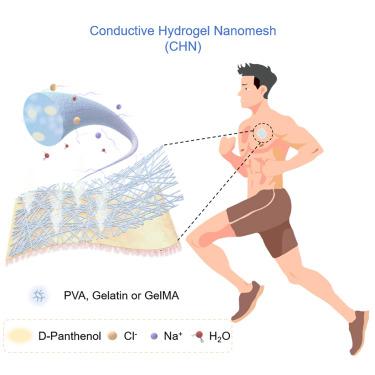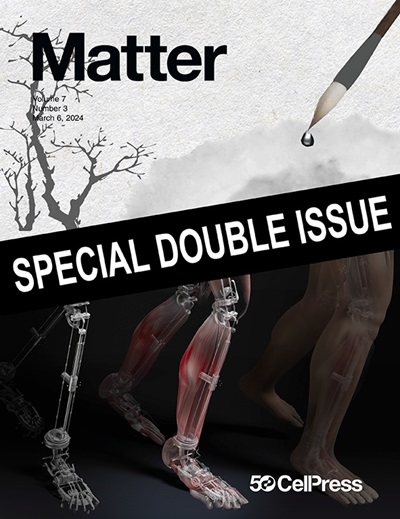汗液激活的导电水凝胶纳米网,用于透气、长期电生理监测和以人为中心的界面
IF 17.5
1区 材料科学
Q1 MATERIALS SCIENCE, MULTIDISCIPLINARY
引用次数: 0
摘要
开发可呼吸和可重复使用的超薄生物电极对连续电生理监测至关重要。薄而干的电极适合长期使用,但失去了水凝胶的优势,如接近零的半电池电位(HCP)和粘附性,这对检测微弱的生理信号至关重要。聚合物纳米网增强的透气性水凝胶电极提供了界面改善,并持续约10天,但延长时间后性能下降。本研究介绍了一种“纺丝-交联-浸泡”(SCS)技术,用于生产超薄(~ 6 μm)、自立导电水凝胶纳米网(CHN)电极,该电极具有汗活化的离子电导率和粘附性,能够动态、长期重复使用。通过制造三种生物相容性CHN电极,证明了SCS技术的多功能性,它们都具有低皮肤阻抗、可忽略的HCP、气体/湿气渗透性和类皮肤力学。与微型柔性电路配合使用,该系统具有高保真的电生理监测功能,可以在100多天内重新激活汗液而不会刺激皮肤。这一创新在长期透气生物电极方面取得了重大进展,促进了健康监测和以人为中心的无缝互动。本文章由计算机程序翻译,如有差异,请以英文原文为准。

Sweat-activated conductive hydrogel nanomesh for breathable, long-term electrophysiological monitoring and human-centric interfaces
Developing breathable and reusable ultrathin bioelectrodes is crucial for continuous electrophysiological monitoring. Thin, dry electrodes suit long-term use but lose hydrogel advantages like near-zero half-cell potential (HCP) and adhesion, critical for detecting weak physiological signals. Polymer nanomesh-reinforced breathable hydrogel electrodes offer interfacial improvement and last ∼10 days, yet performance degrades after extended time. This study introduces a "spinning-crosslinking-soaking" (SCS) technique to produce ultrathin (∼6 μm), self-standing conductive hydrogel nanomesh (CHN) electrodes with sweat-activated ionic conductivity and adhesion, enabling dynamic, long-term reuse. The versatility of the SCS technique was demonstrated by fabricating three types of biocompatible CHN electrodes, all exhibiting low skin impedance, negligible HCP, gas/moisture permeability, and skin-like mechanics. Paired with a miniature flexible circuit, the system exhibits high-fidelity electrophysiological monitoring and can be sweat reactivated for over 100 days without skin irritation. This innovation offers a significant advancement in long-term breathable bioelectrodes, facilitating health monitoring and seamless human-centric interactions.
求助全文
通过发布文献求助,成功后即可免费获取论文全文。
去求助
来源期刊

Matter
MATERIALS SCIENCE, MULTIDISCIPLINARY-
CiteScore
26.30
自引率
2.60%
发文量
367
期刊介绍:
Matter, a monthly journal affiliated with Cell, spans the broad field of materials science from nano to macro levels,covering fundamentals to applications. Embracing groundbreaking technologies,it includes full-length research articles,reviews, perspectives,previews, opinions, personnel stories, and general editorial content.
Matter aims to be the primary resource for researchers in academia and industry, inspiring the next generation of materials scientists.
 求助内容:
求助内容: 应助结果提醒方式:
应助结果提醒方式:


